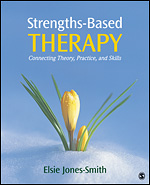Strengths-Based Therapy
Connecting Theory, Practice and Skills
Elsie Jones-Smith - Diplomate in Counseling Psychology, American Board of Professional Psychology
480 pages
| January, 2013
| SAGE Publications, Inc
Instant Access!
eBook
ISBN: 9781483321981
Paperback
ISBN: 9781452217925
$135.00
Instant Access!
eBook
ISBN: 9781483321981
Combining both the theory and practice of strengths-based therapy, Elsie Jones-Smith introduces current and future practitioners to the modern approach of practice—presenting a model for treatment as well as demonstrations in clinical practice across a variety of settings. This highly effective form of therapy supports the idea that clients know best about what has worked and has not worked in their lives, helps them discover positive and effective solutions through their own experiences, and allows therapists to engage their clients in their own therapy.
Drawing from cutting-edge research in neuroscience, positive emotions, empowerment, and change, Strengths-Based Therapy helps readers understand how to get their clients engaged as active participants in treatment.
Drawing from cutting-edge research in neuroscience, positive emotions, empowerment, and change, Strengths-Based Therapy helps readers understand how to get their clients engaged as active participants in treatment.
Available formats
ISBN: 9781483321981
eBook
Suggested Retail Price: $94.24
Bookstore Price: $75.39
ISBN: 9781483321981
eBook
Suggested Retail Price: $52.00
Bookstore Price: $41.60
ISBN: 9781483321981
eBook
Suggested Retail Price: $58.00
Bookstore Price: $46.40
ISBN: 9781483321981
eBook
Suggested Retail Price: $65.00
Bookstore Price: $52.00
ISBN: 9781452217925
Paperback
Suggested Retail Price: $135.00
Bookstore Price: $108.00
See what’s new to this edition by selecting the Features tab on this page. Should you need additional information or have questions regarding the HEOA information provided for this title, including what is new to this edition, please email sageheoa@sagepub.com. Please include your name, contact information, and the name of the title for which you would like more information. For information on the HEOA, please go to http://ed.gov/policy/highered/leg/hea08/index.html.
For assistance with your order: Please email us at textsales@sagepub.com or connect with your SAGE representative.
SAGE
2455 Teller Road
Thousand Oaks, CA 91320
www.sagepub.com
Part I
Chapter 1: Strengths-Based Therapy
Chapter 2: Human Strengths Theory: The Neuroscience and Relational
Chapter 3: Strengths across Cultures
Chapter 4: The Strengths-Based Therapy Model
Chapter 5: Strengths-Based Assessment
Part II
Strengths-Based Recovery: Introduction to Part II, Practice
Chapter 6: Strengths-Based Therapy and Families
Chapter 7: Strengths-Based Therapy and Recovery in Mental Health
Chapter 8: Strengths-Based Therapy, Addiction, and a Harm Reduction Approach
Chapter 9: Strengths-Based School Counseling
Chapter 10: Strengths-Based Therapy: “At-Risk or “At-Promise”
Chapter 11: Strengths-Based Therapy in Correctional Settings
Chapter 12: Strengths-Based Therapy and Older Adults
References
Index
KEY FEATURES:
- Employs a theory-to-practice approach often lacking in other texts
- Draws heavily on cognitive behavioral (evidence-based) approaches
- Lays out a model for use with a variety of client types/settings, including families, mental health settings, schools, substance abuse, and corrections
- Uses clinical illustrations to demonstrate practical applications

